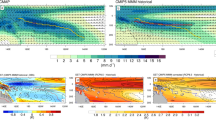Abstract
Following an earlier climatological study of North Pacific Polar Lows by employing dynamical downscaling of NCEP1 reanalysis in the regional climate model COSMO-CLM, the characteristics of Polar Low genesis over the North Pacific under different global warming scenarios are investigated. Simulations based on three scenarios from the Special Report on Emissions Scenarios were conducted using a global climate model (ECHAM5) and used to examine systematic changes in the occurrence of Polar Lows over the twenty first century. The results show that with more greenhouse gas emissions, global air temperature would rise, and the frequency of Polar Lows would decrease. With sea ice melting, the distribution of Polar Low genesis shows a northward shift. In the scenarios with stronger warming there is a larger reduction in the number of Polar Lows.






Similar content being viewed by others
References
Boer GJ, Flato G, Ramsden D (2000) A transient climate change simulation with greenhouse gas and aerosol forcing: projected climate to the twenty-first century. Clim Dyn 16:427–450
Chen F, von Storch H (2013) Trends and variability of North Pacific polar lows. Adv Meterol 2013:1–11. doi:10.1155/2013/170387
Chen F, Geyer B, Zahn M, von Storch H (2012) Toward a multi-decadal climatology of North Pacific Polar Lows employing dynamical downscaling. Terr Atmos Ocean Sci 23:291–301. doi:10.3319/TAO.2011.11.02.01(A
Cox PM, Betts RA, Jones CD et al (2000) Acceleration of global warming due to carbon-cycle feedbacks in a 3D coupled climate model. Nature 408:184–187
Friedlingstein P, Bopp L, Ciais P et al (2001) Positive feedback between future climate change and the carbon cycle. Geophys Res Lett 28:1543. doi:10.1029/2000GL012015
Jungclaus JH, Botzet M, Haak H et al (2005) Ocean circulation and tropical variability in the coupled model. ECHAM5/MPI-OM. J Clim 19:3952–3972
Kolstad EW, Bracegirdle TJ (2008) Marine cold-air outbreaks in the future: an assessment of IPCC AR4 model results for the Northern Hemisphere. Clim Dyn 30:871–885. doi:10.1007/s00382-007-0331-0
Marsland SJ, Haak H, Jungclaus JH et al (2003) The Max-Planck-Institute global ocean/sea ice model with orthogonal curvilinear coordinates. Ocean Model 5:91–127
Meehl GA, Arblaster JM, Tebaldi C (2005) Understanding future patterns of increased precipitation intensity in climate model simulations. Geophys Res Lett 32:L18719. doi:10.1029/2005GL023680
Meehl GA, Covey C, Delworth T et al (2007) The WCRP CMIP3 multi-model dataset: a new era in climate change research. Bull Am Meteorol Soc 88:1383–1394
Nakicenovic N, Alcamo J, Davis G et al (2000) Special report on emissions scenarios: a special report of Working Group III of the intergovernmental panel on climate change
Pinto JG, Ulbrich U, Leckebusch GC et al (2007) Changes in storm track and cyclone activity in three SRES ensemble experiments with the ECHAM5/MPI-OM1 GCM. Clim Dyn 29:195–210. doi:10.1007/s00382-007-0230-4
Räisänen J, Ruokolainen L, Ylhäisi J (2010) Weighting of model results for improving best estimates of climate change. Clim Dyn 35:407–422. doi:10.1007/s00382-009-0659-8
Rasmussen EA, Turner J (2003) Polar lows: mesoscale weather systems in the polar regions. Cambridge University Press, Cambridge
Roeckner E, Bauml G, Bonaventura L et al (2003) The atmospheric general circulation model ECHAM5. PART I: model description. Max-Planck-Institut für Meteorologie, Hamburg
Steppeler J, Doms G, Schättler U et al (2003) Meso-gamma scale forecasts using the nonhydrostatic model LM. Meteorol Atmos Phys 82:75–96. doi:10.1007/s00703-001-0592-9
Stocker TF, Schmittner A (1997) Influence of CO2 emission rates on the stability of the thermohaline circulation. Nature 388:862–865
Yonetani T, Gordon HB (2001) Simulated changes in the frequency of extremes and regional features of seasonal/annual temperature and precipitation when atmospheric CO2 is doubled. J Clim 14:1765–1779. doi:10.1175/1520-0442(2001)014<1765:SCITFO>2.0.CO;2
Zahn M, von Storch H (2008) Tracking Polar Lows in CLM. Meteorol Z 17:445–453. doi:10.1127/0941-2948/2008/0317
Zahn M, von Storch H (2010) Decreased frequency of North Atlantic polar lows associated with future climate warming. Nature 467:309–312. doi:10.1038/nature09388
Acknowledgments
This work is a contribution to the Helmholtz Climate Initiative REKLIM (Regional Climate Change), a joint research project of the Helmholtz Association of German Research Centers. We acknowledge the modeling groups, the Program for Climate Model Diagnosis and Intercomparison (PCMDI) and the WCRP’s Working Group on Coupled Modelling (WGCM) for their roles in making available the WCRP CMIP3 multi-model datasets. Support of these datasets is provided by the Office of Science, U.S. Department of Energy. The authors thank Beate Gardeike for preparing the diagrams. The technical and scientific support, and various comments and suggestions by Dr. Beate Geyer and Dr. Matthias Zahn have greatly improved this manuscript. This research was supported by the Chinese Scholarship Council (CSC), and by the Knowledge Innovation Project for Distinguished Young Scholar of The Chinese Academy of Sciences (No. KZCX2-EW-QN203).
Author information
Authors and Affiliations
Corresponding author
Rights and permissions
About this article
Cite this article
Chen, F., von Storch, H., Zeng, L. et al. Polar Low genesis over the North Pacific under different global warming scenarios. Clim Dyn 43, 3449–3456 (2014). https://doi.org/10.1007/s00382-014-2117-5
Received:
Accepted:
Published:
Issue Date:
DOI: https://doi.org/10.1007/s00382-014-2117-5




